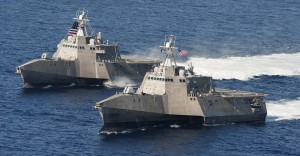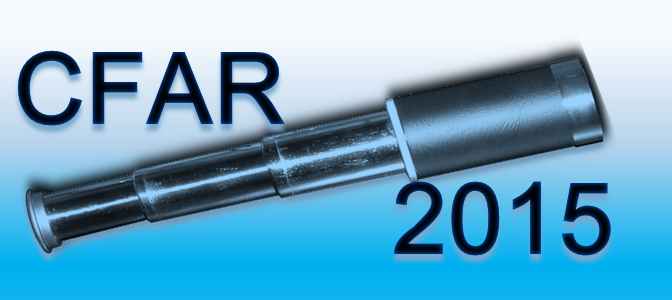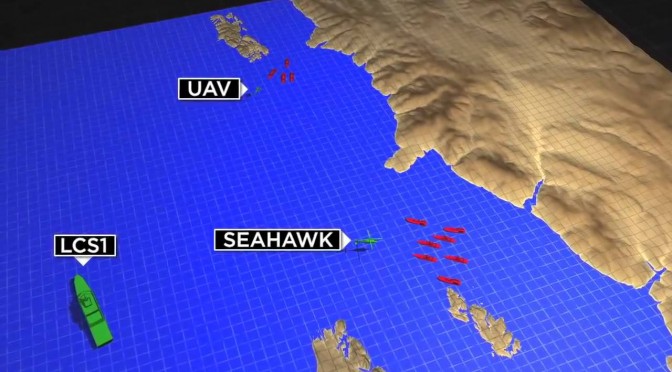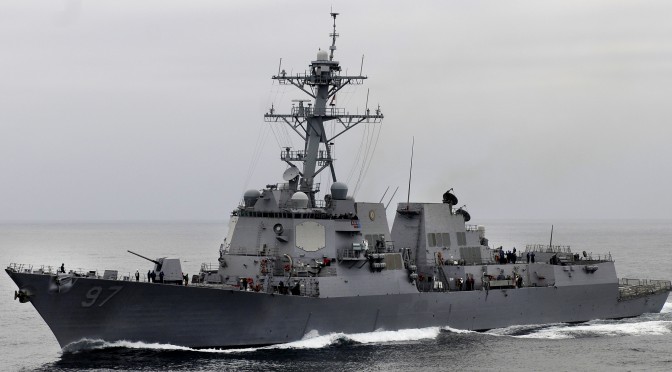 One of the most persistent complaints about the Littoral Combatant Ship (LCS) is that it is not fit to replace the retiring Perry class frigates. LCS has been characterized as under-armed in comparison with the Perry class, and not capable of assuming the roles and missions of a frigate. In light of these criticisms it’s useful to examine what constitutes a frigate in the second decade of the 21st century. What sort of frigate does the U.S. Navy need to meet present requirements? Finally, does the LCS, in both its current form, and as envisioned in the frigate upgrade meet those requirements, particularly in armament? The answers may surprise LCS critics who continue to call for a Cold War frigate as the solution for 21st century naval missions.
One of the most persistent complaints about the Littoral Combatant Ship (LCS) is that it is not fit to replace the retiring Perry class frigates. LCS has been characterized as under-armed in comparison with the Perry class, and not capable of assuming the roles and missions of a frigate. In light of these criticisms it’s useful to examine what constitutes a frigate in the second decade of the 21st century. What sort of frigate does the U.S. Navy need to meet present requirements? Finally, does the LCS, in both its current form, and as envisioned in the frigate upgrade meet those requirements, particularly in armament? The answers may surprise LCS critics who continue to call for a Cold War frigate as the solution for 21st century naval missions.
The definition of the frigate as a naval combatant has been in constant flux since the end of the Second World War. It appeared in the Second World War as a British Royal Navy (RN) classification for an independent antisubmarine warfare vessel. By 1945, the term “frigate” generally meant a ship of 1300-2000 tons; less than 350 feet in length; a speed of less than 25 knots, and an armament focused on antisubmarine weapons.
The U.S. Navy substantively changed the frigate designation after World War 2 with its first generation of purpose-built aircraft carrier escorts. The demise of the Axis surface fleets, the well-established threat from air attack, and the rise of a Soviet Navy based on submarines called for a new, affordable combatant that could meet these challenges. A ship roughly 6000 tons in displacement, a speed comparable to fleet carriers, and capable of mounting significant antiair (AAW) and antisubmarine (ASW) weapons was seen as an ideal cross between the expensive, man-power intensive cruiser and the cheaper, but less capable destroyer class. The new ship was designated first as a “hunter killer” (CL) and later as a “frigate” (DL) with missile armed versions classified as DLG’s. Destroyers, such as the Forrest Sherman class and their missile-armed immediate successors, the Charles Adams class remained general purpose combatants optimized for a variety of roles, but generally less capable than frigates. Smaller combatants optimized for antisubmarine warfare remained labeled as destroyer escorts (DE’s).
This condition persisted until the mid 1970’s. U.S. frigates had approached the size and capabilities of World War 2 cruisers in the California and Virginia class DLGN (nuclear-powered) frigates of 10000 tons and nearly 600 feet in length. The traditional antisubmarine warfare escort had also grown in size and capability. Many of these ships, such as the FF 1052 Knox class were significantly larger than the 1940’s-era ships they were replacing. These changes compelled the U.S. to re-designate a number of its warships in 1975 to better reflect the changes in the frigate classification since 1945, as well as to combat a persistent myth that the U.S. had less cruiser-designated ships than the Soviet Union. The frigates were divided into guided missile cruisers and destroyers based on size and capability. U.S. destroyer escorts were renamed as frigates.
The patrol frigate, later the FFG-7 Oliver Hazard Perry class was the zenith of American Cold War escort design. The Soviet Union was expected to deploy a significant force of subsurface, surface, and aviation platforms to destroy the expected Reforger re-supply convoys crossing the Atlantic to support embattled North Atlantic Treaty Organization (NATO) forces in Western Europe. Unlike previous escort classes, the FFG-7 was designed as a multimission combatant in order to better meet the expanding Soviet threat. It too, like the LCS, ballooned in cost. According to a January 3, 1979 General Accounting Office (GAO) report, the cost per ship increased from 64.8 million dollars a ship in 1973, to 194 million a copy by 1979.
This general classification system of U.S. surface combatants persisted through the end of the Cold War and the first decade of the 2000’s. After 1991, however, the international definition of the frigate category again began to change. Falling defense budgets across the Western world in the wake of the Cold War’s end compelled many nations to put more capabilities into fewer hulls, often designated as frigates, as a cost savings measure. These ships now occupy a place in many European navies analogous to that of the U.S. Arleigh Burke class DDG as the primary surface warships of those nations’ navies. Japan and South Korea have made similar changes, but have retained the destroyer classification for these larger vessels. Russia maintained the Cold War classification structure throughout most of the last 20 years, but its recent frigates are smaller than their late Cold War cousins. The Chinese Navy has followed the Russian Cold War model and gradually increased the size of its frigates as general patrol and escort ships. Although there remain several descriptions of the frigate type warship, the post-Cold War ship now associated the frigate classification has generally grown into a large and capable surface combatant for many nations.
Does the U.S. Navy need a frigate as defined by these new standards? At the end of their service lives, the Perry class had lost much of their (AAW) and (ASUW) sensors and weapons. Their MK 92 fire control system, MK 13 single arm missile launchers, and medium range Standard Missile (SM-1 MR) systems were largely out of date against the growing antiship cruise missile threat by the turn of the century. They had become the early 21st century equivalent of the late 19th century colonial cruiser, whose chief purpose was to show the flag and conduct low-intensity combat operations.
The U.S. high capability combatant class is well filled by the CG 47, DDG 51 and DDG 1000 class ships. Such a mass of AAW capable ships was not in service when the Perry’s were conceived. While the U.S. Navy requires a replacement for the Perry’s “show the flag” role, there appears to be no requirement for another medium capability convoy escort in the tradition of past U.S. frigate designs. The cruise missile threat is considerable for even high capability warships such as the DDG 51. A supporting frigate similar in size and capability to current European designs could be built, but would provide little in the way of additional capability beyond present ships. It would also not be a cost effective product for low end presence missions. Unlike during the Cold War, no potential U.S. opponent yet deploys a global naval force capable of simultaneously effectively threatening U.S. seaborne communications in multiple geographic locations. The absence of this threat for now obviates the need for 21st century version of the FFG-7. If that threat develops, advances in missile and torpedo technology will require high capacity escorts like the DDG 51 rather than a new FFG-7.
The frigate needed for the present Navy is not another Cold War antisubmarine combatant, or an expensive, but less capable version of the DDG 51. It should instead be a general-purpose warship capable of multiple tasks. It must conduct low threat missions such as counter-piracy and presence operations in order to free the DDG force for offensive and defensive missions in high intensity combat. It should be able to perform escort missions for amphibious and logistics force ships for limited periods in appropriate threat environments. The addition of a surface to surface missile armament should allow the frigate to conduct limited ASUW under the Navy’s emerging concept of distributive lethality. LCS’ endurance is 70% of the FFG-7, but it’s still sufficient for extended operations in comparison with smaller corvettes or missile patrol craft. The LCS baseline platform with 57mm gun, Rolling Airframe Missile (RAM), electronic warfare gear, boats, and large flight deck and hangar is an excellent replacement for the FFG-7 in low threat, presence missions. The ship can accomplish escort and additional warfare missions with the weapons and sensors provided in its warfare modules and frigate upgrade. The ship’s modular design readily accepts additional weapons and associated equipment. The frigate upgrade to the basic LCS hull has been derided as insufficient, but only if a 21st century FFG 7 is the desired product. The modifications envisioned for the LCS-based frigate meet current requirements and definitions for the 21st century frigate the Navy requires.
No would deny the LCS program has suffered significant problems over the course of its history. It introduced multiple new technologies in one platform in order to replace three classes of ship. Problems associated with this effort remain and will likely persist for some time. In spite of these issues, the LCS and its frigate variant represent the best choice for replacing the retiring Perry class frigates in their current role as presence, patrol, and low intensity combat platforms, as well as emerging surface warfare missions. The Navy does not need a 21st century Perry class frigate.
Steve Wills is a retired surface warfare officer and a PhD student in military history at Ohio University. His focus areas are modern U.S. naval and military reorganization efforts and British naval strategy and policy from 1889-1941. He posts here at CIMSEC, sailorbob.com and at informationdissemination.org under the pen name of “Lazarus”.






